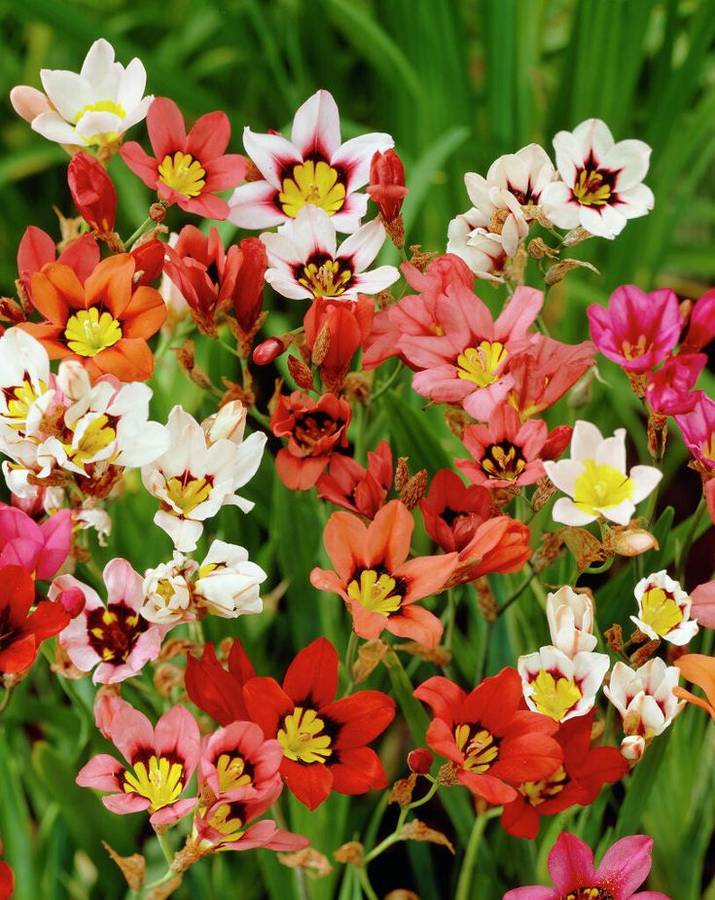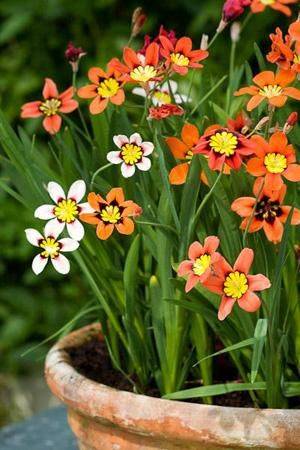





Sparaxis - Mixed - 50 bulbs p-pack
Check my rate
| Main centres: | 1-3 business days |
| Regional areas: | 3-4 business days |
| Remote areas: | 3-5 business days |






| Main centres: | 1-3 business days |
| Regional areas: | 3-4 business days |
| Remote areas: | 3-5 business days |
Sparaxis, also known as Harlequin flowers, is a vibrant and showy bulb that thrives in South Africa's climate, particularly in regions with cooler winters and mild summers. The Sparaxis Mix provides a range of colors in a single planting, adding beautiful contrast and rich hues to gardens. It is often used in flower beds, borders, and containers.
Climate:
Sparaxis grows best in cooler, temperate climates with mild winters.
Ideal planting months: Autumn (March—May) for spring blooms (August—October).
Warm regions (like the Highveld or coastal areas) tend to support good growth, while hot summer areas might struggle with the plant's need for cooler conditions.
Soil Requirements:
Prefers well-draining, sandy-loam or loamy soil.
pH: 6.0—7.5 (neutral to slightly acidic).
Avoid heavy clay soils; amend them with sand or compost to improve drainage.
Best Planting Time:
Autumn (March—May), allowing the bulbs to establish roots before the cooler months and bloom in spring (August—October).
Preparing the Bulbs:
Soak bulbs in lukewarm water for about 2—4 hours before planting to encourage sprouting.
Dry them slightly after soaking to avoid rotting when planted.
Planting Depth & Spacing:
Depth: Plant bulbs 5—7 cm deep.
Spacing: Space bulbs 10—15 cm apart to allow for spreading and good air circulation.
Row spacing: 20—25 cm between rows for optimal growth.
Watering:
Keep the soil moist but not waterlogged, especially during the growing season.
Water deeply once a week during the active growing phase, but reduce watering when plants are dormant.
Once bulbs are established, they are relatively drought-tolerant, but regular watering during flowering will produce the best blooms.
Fertilizing:
Before planting, incorporate organic compost or well-rotted manure into the soil.
During growth, apply a balanced fertilizer (NPK 10-10-10) or one with slightly higher phosphorus to encourage flowering.
Fertilize every 4—6 weeks during the growing season.
Mulching:
Apply a thin layer of organic mulch (like straw or bark) to help with moisture retention and weed control.
Common Pests:
Aphids, thrips, and spider mites — Control with neem oil or insecticidal soap.
Slugs and snails — Use organic slug pellets or copper tape around the base of the plants.
Common Diseases:
Powdery mildew — Improve air circulation by spacing plants well apart and avoid overhead watering.
Root rot — Prevent by planting in well-drained soil and avoid excessive watering.
Blooming Time:
Sparaxis Mix usually blooms 8—12 weeks after planting (from August to October).
Each bulb produces multiple flowers, creating a long-lasting floral display.
Cutting for Bouquets:
Cut when buds are just beginning to open to ensure a longer vase life.
Use sharp scissors or pruners to avoid damaging the plant.
Place cut flowers in cool water immediately for the longest lasting display.
After flowering, allow the foliage to die back naturally.
Lift the bulbs, allow them to dry completely, and store in a cool, dry place until the following autumn.
Replant the bulbs in autumn for the next season.
Companion Plants:
Tulips, daffodils, and ranunculus work well with Sparaxis for a vibrant, spring color display.
Low-growing plants like pansies or alysum can complement Sparaxis while covering the soil.
Crop Rotation:
Rotate the planting of Sparaxis bulbs every year to avoid soil-borne diseases. Avoid planting in areas where other bulb plants (such as lilies or daffodils) have been grown.
Sparaxis Mix provides a stunning array of colors and is well-suited for South African gardens. With its easy care requirements and beautiful blooms, it's a fantastic addi...